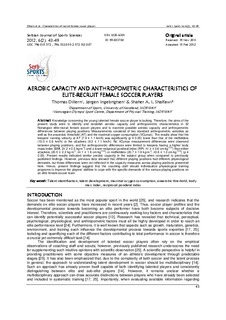| dc.contributor.author | Dillern, Thomas | |
| dc.contributor.author | Ingebrigtsen, Jørgen | |
| dc.contributor.author | Shalfawi, Shaher A.I. | |
| dc.date.accessioned | 2015-07-02T11:52:25Z | |
| dc.date.accessioned | 2015-07-03T10:36:52Z | |
| dc.date.available | 2015-07-02T11:52:25Z | |
| dc.date.available | 2015-07-03T10:36:52Z | |
| dc.date.issued | 2012 | |
| dc.identifier.citation | Dillern, T., Ingebrigtsen, J. & Shalfawi, S.A.I. (2012). Aerobic capacity and anthropometric characteristics of female elite-recruit soccer players. Serbian Journal of Sports Sciences, 6(2), 43-49. Retrieved from https://sjss.sportsacademy.edu.rs/archive/details/general/aerobic-capacity-and-anthropometric-characteristics-of-elite-recruit-female-soccer-players-333.html | nb_NO |
| dc.identifier.issn | 1452-8827 | |
| dc.identifier.uri | http://hdl.handle.net/11250/286445 | |
| dc.description.abstract | Knowledge concerning the young talented female soccer player is lacking. Therefore, the aims of the present study were to identify and establish aerobic capacity and anthropometric characteristics in 32 Norwegian elite-recruit female soccer players and to examine possible aerobic capacity and anthropometric differences between playing positions. Measurements consisted of two standard anthropometric variables as well as the anaerobic threshold (AT) and the maximal oxygen consumption (VO2max). The results show that the keepers’ running velocity at AT (7.9 ± 1.1 km/h) was significantly (p ≤ 0.05) lower than that of the midfielders (10.0 ± 0.6 km/h) or the attackers (9.3 ± 1.1 km/h). No VO2max measurement differences were observed between playing positions, and the anthropometric differences were limited to keepers having a higher body mass index (BMI, 24.2 ± 0.5 kg∙m-2) and a lower reciprocal ponderal index (RPI, 41.4 ± 0.6 cm∙kg-0.33) than either attackers (20.5 ± 2.2 kg∙m-2; 44.1 ± 1.6 cm∙kg-0.33) or midfielders (20.7 ± 1.9 kg∙m-2; 43.6 ± 1.3 cm∙kg-0.33) (p ≤ 0.05). Present results indicated similar aerobic capacity in the subject group when compared to previously published findings. However, previous data showed that different playing positions had different physiological demands, but these differences were not reflected in the capacity measures across playing positions presented here. Hence, present findings suggest that the coaching staff should individualize physiological training programs to improve the players’ abilities to cope with the specific demands of the various playing positions on an elite female soccer team. | nb_NO |
| dc.language.iso | eng | nb_NO |
| dc.publisher | Sports Academy, Belgrade | nb_NO |
| dc.title | Aerobic capacity and anthropometric characteristics of female elite-recruit soccer players | nb_NO |
| dc.type | Journal article | nb_NO |
| dc.type | Peer reviewed | nb_NO |
| dc.date.updated | 2015-07-02T11:52:25Z | |
| dc.subject.nsi | VDP::Social science: 200::Social science in sports: 330 | nb_NO |
| dc.source.pagenumber | 43-49 | nb_NO |
| dc.source.volume | 6 | nb_NO |
| dc.source.journal | Serbian Journal of Sports Sciences | nb_NO |
| dc.source.issue | 2 | nb_NO |
| dc.identifier.cristin | 910026 | |
